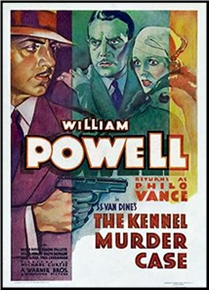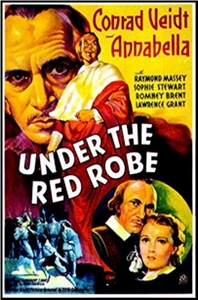November 2022
Monthly Archive
Sun 20 Nov 2022
Posted by Steve under
Reviews[4] Comments
REVIEWED BY DAVID VINEYARD:
JOHN DICKSON CARR – The Crooked Hinge. Dr. Gideon Fell #8. Harper & Brothers, hardcover, 1938. Popular Library #19, paperback, 1944. Reprinted many times.

SHADOWS WERE GATHERING ON the lower slopes of the wood called Hanging Chart, but the flat lands to the left of it were still clear and warm. Set back from the road behind a wall and a screen of trees, the house had those colors of dark-red brick which seem to come from an old painting. It was as smoothed, as arranged, as its own clipped lawns. The windows were tall and narrow, with panes set into a pattern of stone oblongs; and a straight gravel drive led up to the door. Its chimneys stood up thin and close-set against the last light.
No ivy had been allowed to grow against its face. But there was a line of beech-trees set close against the house at the rear. Here a newer wing had been built out from the center—like the body of an inverted letter T—and it divided the Dutch garden into two gardens. On one side of the house the garden was overlooked by the back windows of the library; on the other by the windows of the room in which Sir John Farnleigh and Molly Farnleigh were waiting now.
A clock ticked in this room. It was what might have been called in the eighteenth century a Music Room or Ladies’ Withdrawing Room, and it seemed to indicate the place of the house in this world. A pianoforte stood here, of that wood which in old age seems to resemble polished tortoise-shell. There was silver of age and grace, and a view of the Hanging Chart from its north windows; Molly Farnleigh used it as a sitting-room. It was very warm and quiet here, except for the ticking of the clock.
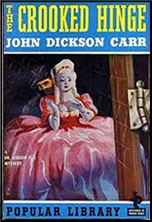
What the Farnleighs are waiting for, though they don’t yet know it, is foul murder, a hint of the supernatural, Satanic cults, possible robot killers (in 1938), and a killer whose lack of genius almost overwhelms the brilliance and eccentricity of Dr. Gideon Fell’s efforts to unravel the mystery.
But pause a moment to admire the literary skill in this little scene at the start of Chapter Two of The Crooked Hinge, a classic Carr mystery. It not only established Farnleigh Close, which is both the setting and the McGuffin that seemingly sets the action in motion but it sets a mood. Chimney’s are “thin and close,†the woods are called Hanging Chart and shadowed ominously, the “silver of age and grace†lays over a room. A clock ticks at the beginning of the paragraph and is brought in again at the end, establishing a tension. Something is coming. Something sinister though nothing concrete has been said to tell us that.
Carr does this effortlessly, his use of metaphor and simile as sharp as Chandler, though applied to a different end.
Even the title, The Crooked Hinge, suggests something sinister about a house, something not quite right about it or the people in it.
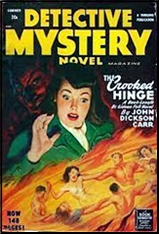
The setting is Kent, where John Farnleigh (“The old-time Farnleighs were an unpleasant lot…â€), a survivor of the Titanic lives with his wife in Farnleigh Close, but another claimant has shown up claiming to be the real John Farnleigh and an inquest is scheduled to establish the truth. Carr tries out his own solution to the famous Tichborne Claimant case.
Then the first Farnleigh is murdered by the pool, his throat slashed in front of three witnesses, and none of them saw anyone do it and the police can’t find the weapon.
Is it the automaton modeled on Maezel’s Chess Player that reaches out to touch a maid and nearly frightens her to death, and who stole the thumbograph, a device for taking fingerprints, not to mention the suggestion of a cult of Satanists. DCI Elliot (…â€youngish, raw-boned, sandy-haired, and serious-minded. He liked argument, and he liked subtleties…â€) investigates and calls on Dr. Fell to sort out the sinister goings on, as he points out:
“But, even believing that this is murder, I still want to know what our problem is.â€
“Our problem is who killed Sir John Farnleigh.â€
“Quite. You still don’t perceive the double-alley of hell into which that leads us. I am worried about this case, because all rules have been violated. All rules have been violated because the wrong man had been chosen for a victim…â€
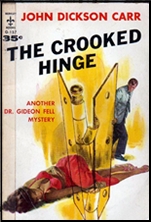
A ranking of the top ten impossible crime mysteries of all time placed this one number four. It is Fell and Carr at their considerable best. It is dedicated to Dorothy L. Sayers.
Just why the wrong man was murdered becomes as important as how. Fell cannot quite lay hands on why the murderer struck and why he has not struck again: “This murder is human, my lad. I’m not, you understand, praising the murderer for this sporting restraint and good manners in refraining from killing people. But, my God, Elliot, the people who have gone in danger from the first! Betty Harbottle might have been killed. A certain lady we know of might have been killed. For a certain man’s safety I’ve had apprehensions from the start. And not one of ’em has been touched. Is it vanity? Or what?â€
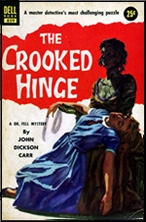
In finding the solution Fell even calls on S. S. Van Dine and Philo Vance’s favorite work, Criminal Investigations: a Practical Textbook by Hans Gross (The Bishop Murder Case) to explain the esoteric but quite real murder weapon (and true to Carr he has laid the groundwork for the killer’s expertise with the weapon) and in a real twist reveal the killer twice in a single chapter.
The Crooked Hinge is Carr and Fell at their best. The mystery sparkles with hints of something unhealthy and outside the realm of the possible, with Fell at his eccentric, high handed, and deceptive finest, and full of well-realized characters just the right side of cardboard, neither overwhelming the story nor mere cut-outs to be moved on the board.
This is a model for the genre, especially that special corner of impossible crime and hints of something sinister and beyond that John Dickson Carr made his own.
Sat 19 Nov 2022
Posted by Steve under
Reviews[4] Comments
REVIEWED BY BARRY GARDNER:
JAMES LEE BURKE – Cadillac Jukebox. Dave Robicheaux #9. Hyperion, hardcover, 1996; paperback, 1997. Reprinted in several editions and printings since.
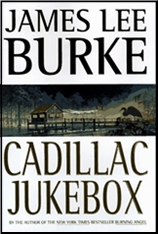
Burke is one of the mainstays now, one of those writers who if you haven’t read him you’re either not a real fan of crime fiction, or you like it only on the lighter side. Every generation of crime writers has a few upon whom posterity bestows the tag of “significant,” and I think he’s one of those.
A former Klansman and forever white trash refugee from the piney woods has finally been imprisoned for the decades-old murder of a black civil rights leader. He swears he is innocent, but no one believes him-except maybe New Iberia cop Dave Robicheaux. A politician who wrote a book about the crime is. about to be elected governor, a film company wants to make a documentary proving the man’s innocence, and a New Orleans hit man accuses Robicheaux of taking a bribe to ignore Crown’s case. Robicheaux had an affair long ago with the politician’s wife, and that just may be the final bit of heat that makes the pot boil over.
There is no question in my mind that Burke is one of the best pure prose stylists ever to grace our field. The man can, to coin a phrase, write like an angel, and in the alcoholic and angst-ridden Robicheaux h has created one of the genre’s enduring characters. His books are dark, lyrical, and yes, occasionally overwrought, and maybe even sometimes confusing.
I’ve never read one of his books I didn’t enjoy while reading it, and enjoy a lot; I have finished a few with some lingering dissatisfaction, particularly those in which indulges his penchant for the supernatural.
Jukebox possesses all Burke’s virtues, and lacks, thank goodness, any ghosts — though he couldn’t resist a little mysticism. Thus I rate it highly, as it deserves, but I’m left with a lingering uneasiness that Burke has said nothing new in his last few books, nor said it in any new ways. And however unfair it may be, sometimes sameness, however fine a sameness, may begin to pall.
— Reprinted from Ah Sweet Mysteries #26, July 1996.
Fri 18 Nov 2022
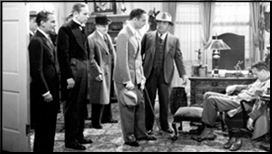
THE KENNEL MURDER CASE. Warner Brothers, 1933. William Powell (as Philo Vance), Mary Astor, Eugene Pallette. Ralph Morgan. Robert McWade. Robert Barrat. Based on the novel by S. S. Van Dine. Director: Michael Curtiz. Currently streaming on Amazon Prime (and perhaps elsewhere).
When a man who is intensely disliked by both his family and friends, it is not big surprise when soon into the movie he’s found dead in his study. What is a surprise is that an examination of his body reveals that not only was he shot, but he was also slugged and then stabbed. At first it is assumed that he committed suicide, especially when his study door has been locked from the inside and the only way to get in (or out) is by breaking the door down.
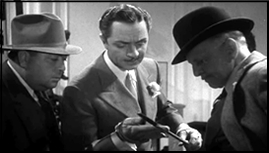
Once suicide has been ruled out, the there two questions: who did it (and there are lots of suspects) and how? The latter is answered quickly enough. Philo Vance, who seems to have an in with the D..A. and free rein on the case, [PLOT ALERT] uses a needle and a short length of thread to demonstrate. [END OF PLOT ALERT]
A dog is eventually used to identify the killer, but even before that, the title of the film is totally justified by it opening scenes, taking place at a championship dog show where all the players seem to have a stake in the action.
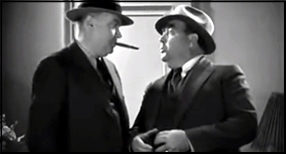
From all accounts, this is a fairly good adaptation of the original Philo Vance novel, and just maybe, too good. It’s not easy getting all the primary plot points of a 300 page book into a movie with only 80 minutes running time, but director Michael Curtiz moves even the draggy bits along at a fast pace. It also does not hurt that all of the players are more than competent in their roles, starting at the top with William Powell who was made to play smoothly urbane roles like this.
Fri 18 Nov 2022
Posted by Steve under
Reviews[7] Comments
REVIEWED BY DAN STUMPF:
MICHAEL ARLEN – Hell! Said the Duchess: A Bedtime Story. Heineman, UK, hardcover, 1934. Doubleday Doran & Co., US, hardcover, 1934. Valancourt Books, softcover, 2013. [NOTE: Horror writer Karl Edward Wagner included Hell! Said the Duchess on his list of “The Thirteen Best Supernatural Horror Novels” in the May 1983 issue of The Twilight Zone Magazine.]
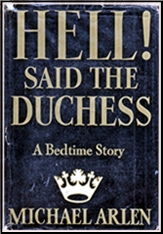
A slim volume, a real curiosity, and a highly enjoyable read.
Michael Arlen is best remembered (if at all) for his best-selling The Green Hat (1924) which is pretty much forgotten these days. And is there anything so terribly forgotten as the best-sellers of another generation?
Not for me. I read The Green Hat (not to be confused with The Green Hornet) and while researching it for a review, I came across mention of this later work. Well, there’s something inside me that will not pass up anything with a title like Hell! Said the Duchess, so I ran down a copy, and discovered a neglected gem.
Plot-wise, this starts out as a rather obvious Murder Mystery: a series of gruesome crimes, dubbed the “Jill the Ripper†murders is terrorizing London in the 1880s, and evidence points unmistakably to a woman who must be innocent — the eponymous Duchess, who is known far and wide ass the very soul of sweetness and light. Police are puzzled, friends are frantic, and confusion is rife.
All this is carried along with a light, humorous prose that reminded me of Oscar Wilde’s Dorian Gray, as in:
“Society… can best be [described] by dividing it into three parts… those who would not be seen dead in the illustrated papers… those who week after week are seen dead in the illustrated papers, and… those who die without having managed to attract the notice of the illustrated papers.â€
Or:
“The history of mankind is a story told in the worst possible taste…. full of false melodrama, purple passages, sinister coincidences, and a sickening want of humanity.â€
The bantering tone fooled me into thinking I had the mystery figured out, only to find that there was no mystery here. Only a terrible truth that surprised & shocked me – if you can imagine being shocked by a work of fiction.
Arlen shifts gears in the last chapter and the ending is a shattering surprise. I can say no more except that I urge you to try it and see if you agree.
Thu 17 Nov 2022
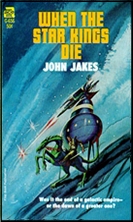
JOHN JAKES – When the Star Kings Die. Dragonard #1. Ace G-656, paperback original, 1967. Cover by Jack Gaughan. Second printing, 1978.
When Max Dragonard, ex-Regulator, is broken out of prison by his old commander, he is assigned to investigate the revolutionary organization called Heart Flag. The Lords of the Exchange, rulers of II Galaxy and previously immortal, are dying, and no one seems to know why. Dragonard is captured by the High Commander of the Regulators and betrays his friend.
At the command of Lord Mishubi II, he is sentenced to die. Escape to the Heart Flag movement reveals to him the secret of immortality which has been kept from the ordinary people of the galaxy.
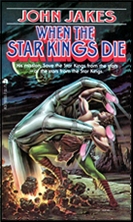
Quite better than expected, the story improves as it continues. One can hardly help but think of the old Planet Stories tradition, but it would seem that there is more complexity and development in this novel than the usual stereotyped space-adventure.
Dragonard’s own mental defect, correction of which was denied him, helps persuade him of the Lords’ treachery, a nice touch. The girl he loves is killed under bitter circumstances, but there is another who is waiting for his love. And Jeremy’s dream of life for all must be destroyed, but only temporarily, to free the galaxy from one man’s control.
Rating: ***½
–February 1968
The Dragonard series –
1 When the Star Kings Die (1967)
2 The Planet Wizard (1969)
3 Tonight We Steal the Stars (1969)
Wed 16 Nov 2022
Posted by Steve under
Reviews[2] Comments
REVIEWED BY MIKE NEVINS:

ERLE STANLEY GARDNER – The Case of the Bigamous Spouse. Perry Mason #65. Morrow, hardcover, 1961. Pocket, paperback, 1963. Many later printings and editions exist.
Here is one of the smoothest Masons of ESG’s last years, with a beautifully mounted plot, tremendous pace and a variety of sharp comments on everything from sales technique and modern marriage to police lawlessness and the· undertaking business.
Mason’s client is a gorgeous book saleswoman who has accidentally discovered that her best friend’s husband is a bigamist — and that he’s ready to kill her to keep his secret. When the bigamist is murdered instead, all hell breaks loose.
There are a few tiny plot flaws, and the solution is rabbit-out-of-a-hat, but still and all it’s a gorgeous entertainment reminiscent of Gardner’s prime.
– This review first appeared in The MYSTERY FANcier, January 1977 (Vol. 1, No. 1)
Tue 15 Nov 2022
Posted by Steve under
Reviews[6] Comments
REVIEWED BY TONY BAER:
EARL EMERSON – Nervous Laughter. PI Thomas Black #3. Avon, paperback original, 1986, 1995 (shown). Fawcett, paperback, 1997.
P.I. Thomas Black (not to be confused with PI novelist Thomas Black (read more here ) is a Seattle-based private detective working in the contemporary world.
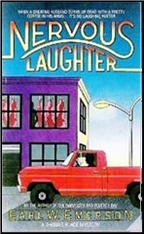
I like it when writers set their work contemporaneously. To me, it’s this world I’m struggling with — not the world of yesteryear. And by “I†I mean “me the reader.†So if I’m looking for answers: for how to live in this world with a modicum of self-respect; for how to make it thru the day — I want a book that is dealing with the ‘present’. Hopefully heroically. “I want you to show me the way†Peter Frampton, or whoever else happens to have a map.
Plus I think it’s a cheat to steal a past that no living reader can possibly remember. If you’re talking 1930, say whatever you want. All I know is what I read in Hammett and see in the movies the same as you, dear author. So you copy Hammett’s setting and make a slightly new version. Big freaking deal.
But you wanna talk 70’s to 2022? I know those times because I’ve lived thru them. So you’re going to have to be credible. You’re gonna have to be real — not Disneyfied.
Black is hired by a gorgeous and flirty jilted wife to tag her hubbie, a dog food mogul, on a suspicion of adultery job. The target immediately kills himself and his lover in a murder suicide. Case closed.
Or is it? Aye — and thar’s the rub.
So how was the book? It’s just okay. There’s nothing wrong with it. It’s real and it’s credible. It’s captivating and hard to put down. It makes sense and everything. But I’m struggling to remember even now, a couple days after shutting the covers. It’s disposable. (Except for getting rid of the bad guy by turning him into canned dog food — that I might remember, ironically: disposing of the disposable bad guy by literally canning him for sale on grocery store shelves).
But the thing with these common, disposable potboilers is they give the listless reader a list. A teleology. A toward-which. An ending. A goal. A solution. A forward momentum towards which you move. Chapter to chapter. Impelled towards the final page with a trajectory of movement into the future.
Books like this take the lost and wayward reader and plunks them down on one of those walking sidewalks at the airport. While you’re reading it, you’re no longer lost. You’ve got a specific place to go. Or at least a fear in back of you, scaring you into scurrying on ahead into the unknown but surely better than whatever fate is chasing you from behind.
I used to work in a bookstore where the staff was roiled by a manager who insisted upon referring to the books as ‘product’. The bibliophile wants to rescue the book from the world of commodities and make of it a fetish, free from this world of objects, existing solely in the soul. In ‘the life of the mind’ (to quote Barton Fink).
But this type of book is surely a commodity. Kind of like crack or speed or anti-depressants. It’s a salve for what ails you. But temporary. And disposable.
And as soon as you’re done you need another just like it. Forevermore. Til death do us part.
Mon 14 Nov 2022
Posted by Steve under
Reviews[5] Comments
DAY KEENE – My Flesh Is Sweet. Lion #68, paperback original, September 1951. MacFadden-Bartell, paperback, 1969. Stark House Press, trade paperback, 2005, in a two-for-one combo with Framed in Guilt, another Day Keene novel. Armchair Fiction, softcover, 2020.
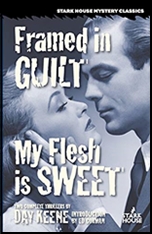
Mystery novels for which the setting involves either pulp writers or the pulp magazine industry are few and far between, and those which do ought to be well noted and documented, even if they’re not very good. As it so happens, this is one, and it’s actually a rather good one, indeed – not surprisingly, as it’s by one of the better paperback writers of the day, Day Keene.
It begins in Mexico City, as pulp fiction writer Ad Connors witnesses an automobile accident involving a Mexican general and a beautiful American tourist, female. Who’s at fault? The general, of course, but who in Mexico would believe her, her word against his? Connors decides to intervene, which as you know if you’ve ever read a novel by Day Keene before, is rather a hasty (and regrettable) decision on his part.
Connors has been in Mexico trying to write the great American novel. It hasn’t worked out. All he has to his name is a few pesos and his typewriter, and the latter is stolen as he manages to get Miss Elena Hayes out of the trouble she’s in. But not completely. Later that evening Connors has to intervene again, this time in Elena’s hotel room and in shall we say, compromising terms and with the general shot and presumably dead.
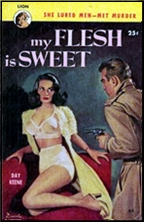
Whether he is or not, Mexico City is no place to be found at a time such as this. Flight is their only choice. And as they head for a safe haven, Ad learns more about Elena and why she’s in Mexico. A lawyer there should be able to vouch for her birth, that her parents were married. Why is this important? She is about to be married back in the States, and to a very wealthy man.
It perhaps need not be said that she does not love this man.
The book thus falls into two parts. I found the first, as the two fugitives manage to stay just a few days ahead of the law, only to become involved in another murder, to be the more interesting. The second half, back in the USA, is another murder mystery to be solved, one involving the disappearance of Elena’s father when she was young back in the far distant past, and yet another murder.
This is, of course, the key to the tale Keene is keen to tell, but what happens in the first half of the book is considerably more vivid and alive, or so it read to me. The cover of the Lion edition makes the story seem to be lurid and just a little sleazy, and maybe it was, back in 1951. Today, though, it’s quite tame in that regard, if not out-and-out tepid. The overall murder mystery is well done, though, and Keene makes the page fly by.
Getting back to the pulp writing business, though, I should like to point out that to finance his and Elena’s escape from Mexico, Connors has to hammer out two stories in a week or so and get them sold. Not only that, but the two stories are closely related to the two halves of My Flesh Is Sweet itself, with only a few modifications. Which are important, too, and neatly so.
Sun 13 Nov 2022
Posted by Steve under
Reviews[2] Comments
REVIEWED BY DAVID VINEYARD:
ARCHIE ROY – Devil in the Darkness. John Long, UK, hardcover, 1978. Valancourt Books, US, trade paperback, 2016.
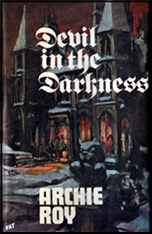
It’s cold and rather gloomy outside, and I find myself in the mood for an old fashioned haunted house thriller.
Sooner or later this house’s days will be ended and it will be demolished. For no house stands for ever. And when this happens, what I have done will be discovered…There are a number of possibilities that may, if any of them occurs, cause the house’s secret to be revealed long before its life is over.
However it happens I want no one else to be blamed for what I have done.
Ardvreck House stands alone in Scotland, a house deserted as much by its bad reputation as by its lonely location. Paul and Carol Wilson are newlyweds caught in a sudden April snowstorm driving across the Ardnamurchan Peninsula toward the cottage they have rented for their honeymoon when the storm forces them off the road.
Luckily for them there is a house nearby.
Well, some would call it luck.
Inside Ardvreck House they are greeted by nine disparate people who don’t immediately explain what it is they are doing in this dreary house without electric power. They welcome Paul and Carol though and provide them with a room to ride out the storm, but that night Paul is suddenly awakened.
And then he heard the noise. It came from the ceiling. The sound of footsteps. A heavy, measured tread back and forth, from the area of the bay window to the centre of the room. Back and forth. The sound of a heavy man’s regular pacing… The room above? Was there another floor to the house?
…Half-formulated speculations he had not dared to voice to Carol surfaced in his mind again. That this group of people had no permission to be in this dilapidated house at all – that they had some illegal purpose – that the army-type men were bogus – that he and Carol were in some kind of deadly danger. Before, those thoughts had seemed melodramatic; now in the low-confidence hours of the night he was not so quick to dismiss them.
Paul can rest assured the individuals in Ardvreck House have permission to be there, but there is nothing reassuring about their legal reason for being there. The “army types†are demolitions experts who have been hired to bring down Ardvreck House, destroy it, and the others are paranormal investigators.
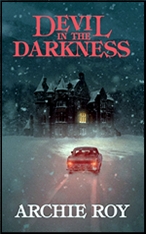
Ardvreck House is one of the most notorious haunted houses in the United Kingdom and has been for almost a century. People have died in Ardvreck House.
Archie Roy must seem an unlikely candidate to be writing supernatural thrillers. To begin he is that Archie Roy, Professor Archie Roy of the University of Glasgow, the astronomer who calculated the orbital trajectory of objects in space for NASA in the Sixties including the 1969 moon landing. He was a Fellow of the Royal Society of Edinburgh and the Royal Society of Astronomers as well as the British Interplanetary Society with an asteroid named after him in 1986.
He was also the author of three previous scientific thrillers in the Buchan vein.
But those weren’t his qualifications here. Far more important here is the fact he was his membership in both the London and Scottish Societies for Phychical Research and as author of A Sense of Something Strange, Archives of the Mind and Eaters of the Dead, and his reputation as the “Glasgow Ghostbuster†(unlike other psychical investigators with scientific reputations Roy did not abandon the Scientific Method when looking into the uncanny, the paranormal was always his last resort) he was more than qualified to take on the paranormal.
And that rigorous mind is part of what he brings to Devil in the Darkness as his team of innocents, psychical researchers, and hard headed demolition experts confront the horrors of Ardvreck House while the blizzard outside traps them and the madness inside the walls of the house tries to stop its secrets from being uncovered. Unlike most horror novels that rely on their chills from the credulity and often stupid behavior of their characters Roy seeks every rational explanation before turning to the paranormal and his characters behave as logically as policemen in their investigation.
The result is the real chills are greater and more disturbing than the artificial kind when some lady in a filmy negligee and high heels armed only with a candle goes exploring in the basement after midnight because she heard strange noises.
The stakes are higher here, the threat more real.
… From the direction of the kitchen a slithering sound had come. Their eyes staring at the closed double doors, the four listened intently. Behind the doors the slithering was repeated, softly and surreptitiously. And a heavy metallic, hollow thud was heard, familiar to Paul, agonizingly so because he could not place it. A scraping sound followed.
It seemed to Paul as if his spinal fluid had been replaced by ice-water. A wave of fear passed over him like a chill breeze from the roofless hall. Was it his imagination or did one of the doors actually ease towards them a little as if under a cautious, testing pressure from the other side?
There were more noises; a trundling sound which lasted all of four seconds was succeeded by a fresh bout of scraping and scratching. Somehow he managed to take the first step towards the kitchen doors.
‘What are you going to do?’ Joyce hissed.
‘Open them.’
‘No!’ Carol was on her feet by now.
‘They may only be noises.’
‘No. Don’t open the doors.’
“Don’t open the doors,†good advice in any supernatural thriller, and hope they don’t open themselves. While Devil in the Darkness isn’t in a class with Shirley Jackson’s The Haunting of Hill House, it could sit comfortably on the shelf with it, Richard Matheson’s Hell House, Russell Kirk’s The Old Dark House of Fear, Dorothy MacCardle’s The Univited, Stephen King’s The Shining, and J. B. Priestley’s Benighted (filmed as The Old Dark House), and that’s as fine a collection of damned and doomed architecture as you can hope to find.
Something to savor on a cold stormy night beneath a warm throw with a medicinal cat in your lap and a good dog at your feet, and the beverage of your choice, fortified or not, at your hand.
And whatever you do when the cat suddenly arches her spine and hackles rise on the dog as he growls menacingly, don’t open the door…
Sat 12 Nov 2022
REVIEWED BY DAN STUMPF:
UNDER THE RED ROBE. 20th Century Fox, UK/US, 1937. Conrad Veidt, Annabella, Raymond Massey, Romney Brent, Sophie Stewart, Wyndham Goldie. Based on the 1894 novel by Stanley J. Weyman. Director: Victor Seastrom.
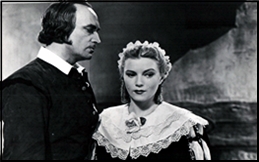
Everyone remembers Conrad Veidt as the Nasty Nazi in Casablanca; a few recall him as the baddie in Thief of Baghdad, and, at a stretch, might recollect his forays into Warner Brothers villainy in A Woman’s Face or All Through the Night.
There was a time, though, when Veidt was a Big Star in the early German Cinema, starting in Cabinet of Caligari, and on through Student of Prague and Hands of Orlac, and when he and his Jewish wife exiled themselves from Germany in the 30s, there was a serious attempt to translate his stardom to English-speaking moviegoers.
He even became something of a cause celebre when he visited Germany just prior to World War II and was “detained” by the Nazis for “health reasons”, eventually being rescued by a team of British doctors.
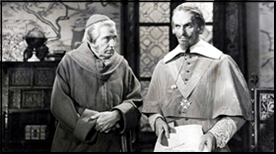
Red Robe is one of the films they were making in England when they thought Veidt would be a Big Star, but weren’t quite sure what to do with him. He plays a 17th century swashbuckler in the sometimes-employ of Cardinal Richelieu (Raymond Massey) who is sent to the Spanish border to capture a rebellious nobleman and ends up enamoured of his target’s sister (Annabella).
Not a very exciting film, but not a bad one either. Victor Seastrom directs with an eye for Pomp and Tapestry, Veidt plays the lethal swordsman in the jaded style of a William S. Hart gunfighter, and there’s a charming turn by Romney Brent as Veidt’s watchdog. With a cast like that, Under the Red Robe has barely enough star-power to illuminate even a tiny TV screen, so it’s not apt to turn up at video stores or on television, but it’s worth catching.
— Reprinted from A Shropshire Sleuth #78, July 1996.
« Previous Page — Next Page »









